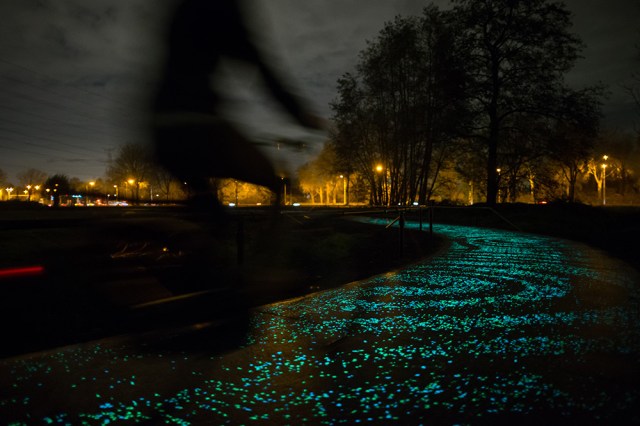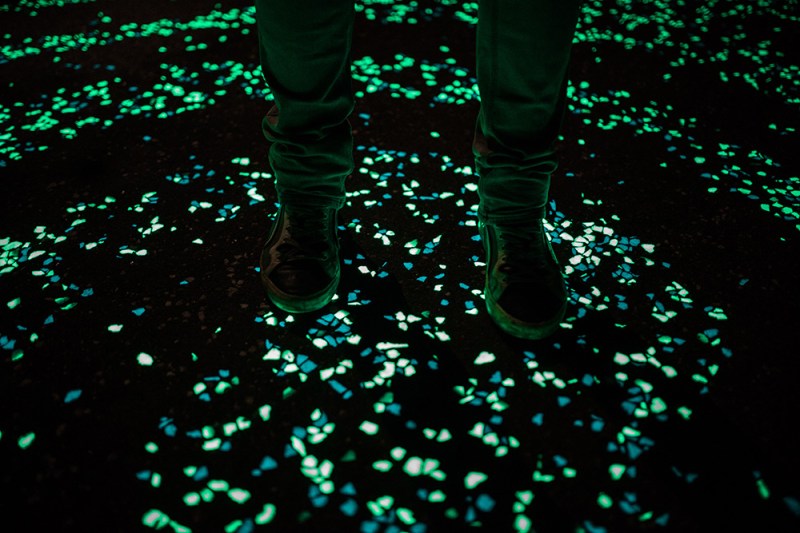When functional engineering blends itself with design and aesthetics, the things we encounter in daily life make the world a more exciting place to be. Artist, [Daan Roosegaarde’s] solar-powered walkway was unveiled last night in Nuenen, Netherlands, illuminating a kilometer long pathway with swirling light, transforming the space visually with functionality.
If the blue and green flowing spirals look familiar, that’s because they were inspired by the painting, Starry Night by Vincent Van Gogh, who was a resident of Nuenen for part of his life. The mosaic-like shapes arranged throughout the path are coated in a special paint containing a chemical that absorbs sun light in order to glow effectively for up to ten hours over night.
 This project is the second installment of [Studio Roosegaarde’s] Smart Highways Research; the larger goal of which is to integrate new technology with roads in an artistically inspired approach to make commuting safer and more energy-efficient. In a few other similar incentives, [Roosegaarde] envisions using this same glowing paint for road markings as a means to help replace the need for street lights. The paint coating he proposes would also be temperature sensitive and capable of creating images to indicate to drivers when there may be ice present due to freezing. His ideas for upgraded roads include a priority lane that could recharge electric cars by means of induction coils built-in underneath them. Even cooler yet, [Roosegaarde] has also proposed the possibility of engineering trees to contain the bioluminescent qualities of some jellyfish and mushrooms so that they too can help replace costly artificial light outdoors. Since some of these technologies are set to be implemented in parts of the Netherlands in the coming years, the re-envisioned environmentally aware future could very well look like a fantasy scene from a painting.
This project is the second installment of [Studio Roosegaarde’s] Smart Highways Research; the larger goal of which is to integrate new technology with roads in an artistically inspired approach to make commuting safer and more energy-efficient. In a few other similar incentives, [Roosegaarde] envisions using this same glowing paint for road markings as a means to help replace the need for street lights. The paint coating he proposes would also be temperature sensitive and capable of creating images to indicate to drivers when there may be ice present due to freezing. His ideas for upgraded roads include a priority lane that could recharge electric cars by means of induction coils built-in underneath them. Even cooler yet, [Roosegaarde] has also proposed the possibility of engineering trees to contain the bioluminescent qualities of some jellyfish and mushrooms so that they too can help replace costly artificial light outdoors. Since some of these technologies are set to be implemented in parts of the Netherlands in the coming years, the re-envisioned environmentally aware future could very well look like a fantasy scene from a painting.
















Looks cool, but not very cost effective. Even when roads are made from tough and cheap materials as asphalt and concrete, they are very expensive and require a lot of maintenance. Combining this with expensive and fragile solar and light technology isn’t good engineering. Boring old fashioned roads, with overhead lights, and reflective paint are still a better option.
Yeh, but good engineering doesn’t provide these folks with that warm feeling in the pit of their stomach that they are ‘doing good’…
This walkway has nothing to do with solar technology. It’s a sidewalk sprinkled with glow in the dark pebbles.
cost effectiveness is a complicated equation, but “fragile” is not necessarily true. Glass can be made very hard indeed – especially if we are talking about compression from the top.
SOLAR POWERED FREAKIN WALKWAYS!
I was expecting this one :)
I don’t think engineering and art should be seperate, but a balance between form and function when possible and especially in public spaces. DaVinci didn’t see that there was a difference. We need more art in our engineering and more engineering in our art. The reason we don’t live in the future that was imagined is that we stop too soon in our design.
OK trolls, let it roll…
As long as it’s beautiful, and doesn’t impact the function. A lot of so-called art is just plain overpriced crap, especially when it’s funded by public money.
agreed. Theres a public installation near here thats effectively some children’s swings, only they don’t work because they are “art”. This annoys me a lot more then it probably should.
No, I totally agree. =]
When you hybrid two areas of thought, it creates a whole new stage for things to be created upon. I personally get a little excited when I see stuff like this because it shows that there are parts of the world where people are willing to completely re-imagine the functional world, rather than cling to what’s familiar. Also, the art is in the idea, not just what you see visually.
Bioluminescent Freakin Roadways!
Having to feed the roads is an interesting prospect.
Let them eat CO2
Artistically, this walkway is quite beautiful. However, this:
“Even cooler yet, [Roosegaarde] has also proposed the possibility of engineering trees to contain the bioluminescent qualities of some jellyfish and mushrooms so that they too can help replace costly artificial light outdoors.”
Sounds like a remarkably bad idea. Consider Glofish, the zebra danios which have been genetically engineered to produce fluorescent proteins. As part of their environmental impact reports, the maker claims:
1) All Glofish are chemically sterilized, and if released into the wild, are incapable of reproduction or crossbreeding with normal zebra danios.
2) An unmodified danio, given the choice of unmodified and modified mates, will almost always choose an unmodified one. The reason given is that the extra metabolic cost of producing the fluorescent protein leaves the modified danios with less energy to put on competitive mating displays.
As for #1, the chemical sterilization is obviously fallible, as I’ve bred Glofish. #2 at least appears to be true. I have noticed Glofish in general are less robust than unmodified zebra danios, although perhaps this could be in part due to excessive inbreeding. However, part of my spawn expressed *two* differing fluorescent proteins, one from each parent. This was ultimately lethal, not a single one made it to maturity.
And [Roosegaarde] is talking about doing this with trees? Trees are quite poor at capturing solar energy, only 1-2% efficiency if I remember correctly. The metabolic cost of *actively* producing light through bioluminescence would probably be higher than producing a fluorescent protein that only converts UV to other colors of light. Much higher if the efficiency of conversion from energy to light is poor. This would likely lead to some sickly trees, that only produce feeble amounts of light. And with no reliable method of preventing cross-pollination between them and normal species. The ongoing difficulties of keeping Monsanto’s modified genes out of what are supposed to be unmodified corn crops comes to mind.
Producing light via artificial means may in fact be the greener option if you consider all the issues, rather than just assuming it must be green if it involves trees..
Admittedly, I’m not an expert on a lot of things. I agree, genetically modifying plants is just as unnatural as all the other crap we’re doing to the environment and would have its own effects. Even if it turns out to be impossible or less efficient in the end, the idea still has merit as an alternative thought which might start a dialogue that leads to someone coming up with something else that does make sense in the world.
There’s always those algae lamps:
https://www.youtube.com/watch?v=M7CCkFM6l74
They also consume a ton of CO2.
You have a good point. Ideas can come from strange places. And if LETs (light-emitting trees) aren’t practical today, they will be eventually. Maybe around the same time it might also be possible to start replacing power “plants” with actual plants. That’s something I’d like to live to see.
i was looking at these a while ago http://www.coregravel.ca/core-glow/ they’re ok
Neat design, but these materials have been around for some time now – they suffer the usual GID shortcomings (they will fade as the night goes on and a covering of snow/mud/dirt will make them dim or dark). Bonus points if they think of a few UV LED lights to keep them bright in the night though.
Smooth-On has some new glow pigments that emit light for many hours.
It’s an art installation. Enjoy it for what it is. The BS they’re feeding the bureaucrats- who cares?